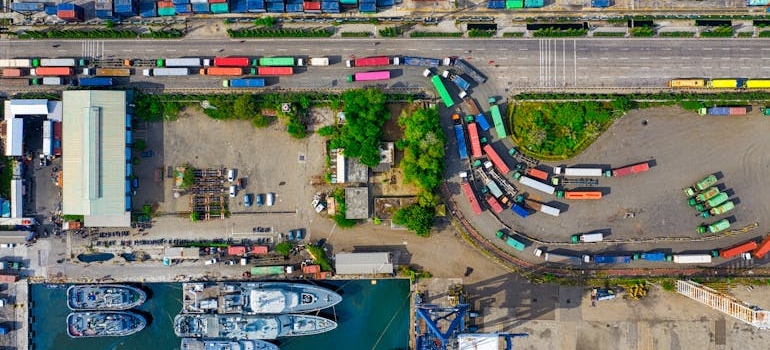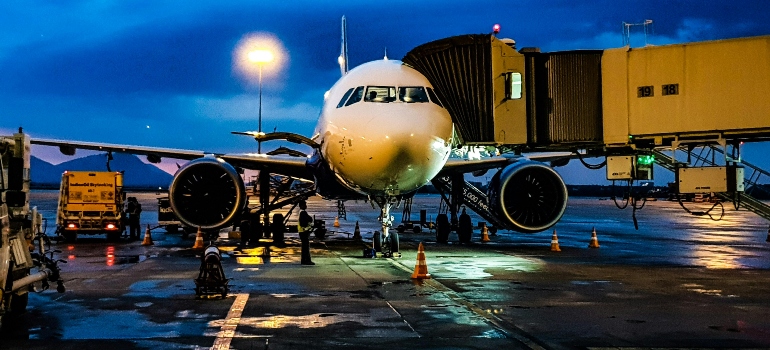Things to Know Before Shipping Your Belongings Abroad
Moving to a new country is an exciting opportunity, but the process of shipping personal belongings across borders can be challenging. Unlike domestic moves, international shipping involves navigating customs regulations, choosing the right shipping method, and ensuring your items arrive safely without unexpected delays or costs. Many people underestimate the complexities of shipping abroad. A simple oversight—such as failing to declare an item properly or choosing the wrong freight option—can lead to expensive fines, customs holds, or even confiscation. This Peasley Moving & Storage Boise guide breaks down everything you need to know before shipping your belongings abroad as a clear roadmap to make the process smooth and safe.
Understanding International Shipping Regulations
Shipping belongings across international borders involves more than just packing boxes. Every country enforces specific import laws that dictate what can be brought in, how shipments should be documented, and what fees may apply. Ignoring these regulations can lead to shipment holds, fines, or outright rejection of your goods.
Why Regulations Matter
Each country enforces different customs laws, restricted items, and tax policies that affect what you can ship and how your items will be processed upon arrival. Some countries prohibit the import of everyday items like wooden furniture, alcohol, or even second-hand clothing. Others impose high import duties on personal belongings, making it more expensive than expected to bring your possessions into the country.
Ignoring these regulations can lead to:
- Delays at customs if documentation is incomplete or incorrect.
- Hefty import duties that significantly increase shipping costs.
- Confiscation or destruction of prohibited items.
Checking the customs website of your destination country before shipping ensures you comply with local regulations and avoid unnecessary headaches.

Restricted and Prohibited Items
Every country has a list of restricted and prohibited goods that cannot be shipped without prior approval. Some common restrictions include flammable materials, pharmaceuticals, perishable foods, and high-value electronics. Even seemingly harmless items like wooden furniture, antique books, and lithium battery-powered devices may require additional documentation or undergo inspection upon arrival.
Medications are particularly tricky since many prescription drugs that are legal in one country may be classified as controlled substances elsewhere. Some nations also impose restrictions on second-hand items, requiring proof of purchase or additional clearance before they can be imported.
Required Customs Documentation
International shipping requires detailed paperwork to ensure that your belongings clear customs smoothly. Before you start looking for “container shipping companies near me“, keep in mind that a complete and accurate inventory list is often mandatory. It is specifying each item, its quantity, and estimated value. Customs officials use this information to assess duties and taxes, and any discrepancies can result in shipment delays.
Most countries require:
- A detailed inventory list describing the contents of your shipment.
- A customs declaration form specifying the value of your items.
- Proof of identity, such as a passport or residence permit.
- In some cases, an import permit for high-value or restricted items.
In addition to an inventory list, most countries require a customs declaration form, which provides details about the shipment’s purpose and value. Some items may also need an import permit or a certificate of origin, especially if they fall under restricted categories.
Passports, visas, and proof of residence may also be required for personal shipments. Ensuring that all documentation is correctly prepared before shipping can prevent unnecessary delays and additional fees. Also, accuracy is key. Mislabeling items or underestimating their value can lead to additional inspections and longer processing times at customs.
Choosing the Right Shipping Method
Selecting the most appropriate shipping method depends on several factors, including the size of your shipment, delivery timeline, and budget. The two most common options are air freight and sea freight, each offering distinct advantages depending on your needs.
Air Freight vs. Sea Freight
For those needing their belongings to arrive quickly, air freight is the fastest option. Most shipments arrive within a few days to a week, making this method ideal for urgent deliveries, high-value goods, or fragile items that require careful handling. However, air freight is significantly more expensive than sea freight, and most airlines impose strict weight and size limitations, making it impractical for large moves.
Sea freight, on the other hand, is the most cost-effective option for large shipments, but it requires patience. Transit times vary widely, often taking several weeks to a few months depending on the route and customs processing. This method is ideal for those moving entire households, as it allows for greater volume at a lower cost. However, delays due to port congestion, customs inspections, or unforeseen logistical issues are common.

Full Container Load (FCL) vs. Less than Container Load (LCL)
If opting for sea freight, there are two main container options: Full Container Load (FCL) and Less than Container Load (LCL). FCL shipments are ideal for those moving large quantities, as they provide exclusive use of a container. This ensures faster delivery, fewer handling risks, and greater security for valuable items.
For those shipping fewer belongings, LCL shipments allow multiple shippers to share space in a single container. While this reduces costs, it also means longer transit times, as shipments must be consolidated and deconsolidated at various points. Additionally, because goods are handled more frequently, there is a slightly higher risk of damage or misplacement compared to FCL shipments.
Working with a Reliable Shipping Provider
Choosing the right shipping provider is crucial for a safe and stress-free experience. Some companies offer comprehensive door to door shipping international services, handling everything from packing and documentation to final delivery. Others focus solely on transportation, requiring you to manage customs clearance and local delivery yourself.
A reputable shipping provider should have experience in international logistics, transparent pricing, and a strong customer support system. It’s also essential to review their policies on insurance, tracking capabilities, and how they handle unexpected delays or lost shipments. Comparing multiple providers and reading customer reviews can help ensure that you select a reliable service that meets your specific needs.
Calculating Costs and Budgeting for International Shipping
Before shipping your belongings abroad, keep in mind that it can be surprisingly expensive, and failing to account for all associated costs may lead to financial strain. The final price of international shipping isn’t just determined by transportation fees but also import duties, storage fees, and customs clearance charges.
Factors That Influence Shipping Costs
The cost of shipping varies depending on several factors. Distance and destination play a major role, as longer shipping routes and remote locations typically incur higher costs. The size and weight of the shipment also impact pricing, with bulkier items requiring more space and potentially triggering additional fees.
The chosen shipping method—air freight or sea freight—also significantly affects overall costs. Air freight is more expensive but offers faster transit times, while sea freight is budget-friendly but requires longer wait periods. Additionally, seasonal surcharges may apply during peak moving seasons, increasing costs unexpectedly.
Understanding Import Taxes and Hidden Fees
Beyond standard shipping charges, many countries impose import duties and taxes based on the declared value of the goods. Some nations allow personal belongings to enter duty-free under certain conditions, while others heavily tax used household items, making it financially impractical to ship them.
Storage fees may also apply if customs holds your shipment for inspection. Port handling fees, customs brokerage charges, and last-mile delivery costs can add to the total expense. Being aware of these potential charges helps avoid unexpected financial burdens and allows for better budgeting.

Packing for International Shipping – What You Need to Know
Proper packing is just as important as choosing the right shipping method. International shipments often pass through multiple checkpoints, endure long transit times, and experience rough handling. Without careful preparation, fragile and valuable belongings can suffer damage before they even reach their destination.
Choosing the Right Packing Materials
Unlike local moves, where belongings are typically handled only a few times, international shipments face frequent transfers between warehouses, ports, and customs facilities. Using high-quality packing materials is the best way to protect against rough handling and environmental conditions such as humidity and temperature changes.
Sturdy, double-walled moving boxes in Boise are essential for protecting delicate or breakable items. Corrugated cardboard provides extra strength, reducing the risk of crushing under pressure. Fragile belongings, such as glassware, ceramics, or electronics, should be wrapped individually in bubble wrap or foam padding to absorb shocks during transit.
Additionally, plastic covers or vacuum-sealed bags can protect textiles and clothing from moisture and dust. For large or oddly shaped items, wooden crates offer the best protection. Shipping companies often recommend custom-built crates for artwork, antiques, and delicate furniture, as they provide added security against impact damage.
Packing Strategies for Safe Transport
Packing isn’t just about using the right materials—it’s also about arranging items correctly to prevent shifting and breakage. Heavy items should always be placed at the bottom of boxes, with lighter, more delicate belongings stacked on top. Any empty spaces inside boxes should be filled with packing peanuts, crumpled paper, or air cushions to prevent movement during transport.
Labeling is another crucial aspect of packing when using medical equipment shipping services. Boxes should be marked with fragile, this side up, or handle with care labels when needed. Additionally, keeping an organized inventory of what’s inside each box makes customs clearance easier and allows for quicker identification if a shipment gets delayed or misplaced.
Tracking, Delivery, and Potential Delays
Once a shipment is in transit, staying informed about its status is crucial. International shipping comes with inherent risks, including customs delays, missed connections, and logistical setbacks. Understanding how to track a shipment and handle unexpected problems can prevent unnecessary stress.
How to Track Your Shipment
Most international shipping companies provide tracking services that allow customers to monitor their shipments in real time. Tracking numbers can be used on carrier websites to check the status of a package, from departure to arrival. Some shipping companies also offer email or SMS updates, providing notifications about customs clearance, estimated delivery dates, and potential delays.
If a shipment is delayed, tracking updates usually provide information about the reason. Customs holds, weather disruptions, and port congestion are among the most common causes of extended transit times. Staying proactive by regularly checking the shipment’s status ensures that any actions, such as providing additional documents or paying import duties, proceed promptly.
Customs Clearance and Delivery Timelines
Customs clearance can take anywhere from a few hours to several weeks, depending on the destination country’s import policies and the accuracy of the documentation provided. If customs officials require further inspection, the process may take longer. Once a shipment clears customs, the final delivery phase begins.
Door-to-door shipping services handle this last leg of the journey, while port-to-port services require recipients to arrange local transportation. To avoid last-minute complications before shipping your belongings abroad, it’s always best to confirm the expected customs processing time for the destination country and prepare all necessary documents in advance.

Handling Unexpected Issues
Even with the best planning, international shipments can encounter unexpected problems. If a package is still at customs, missing paperwork is often the cause. In such cases, contacting the shipping provider or customs office directly can speed up the resolution process.
If a shipment is damaged or lost in transit, filing an insurance claim quickly is essential. Most shipping providers offer insurance coverage options, but the client must submit claims within a specific timeframe. Having photos of packed items, receipts, and shipment tracking details helps strengthen claims and ensures a smoother resolution.
Making International Shipping Smooth and Stress-Free
Shipping belongings abroad requires more than just packing a few boxes and hiring a shipping company. It’s a process that involves customs regulations, packing strategies, selection of shipping method, as well as one of the freight companies in Idaho, and careful budgeting to avoid costly mistakes. Staying proactive throughout the shipment process is essential.
Keeping track of the package’s progress, ensuring all customs paperwork is in order, and preparing for potential delays, prevents many common issues associated with international shipping. Ultimately, the key to a successful and stress-free move is thorough preparation before shipping your belongings abroad. Whether using air freight for urgent items or sea freight for a full household relocation, with the right approach, your belongings will arrive safely, allowing you to focus on settling into your new home abroad.

Everyone from the packers to the movers were awesome! They were all very professional and showed up when they were supposed to. would definitely use them again.

